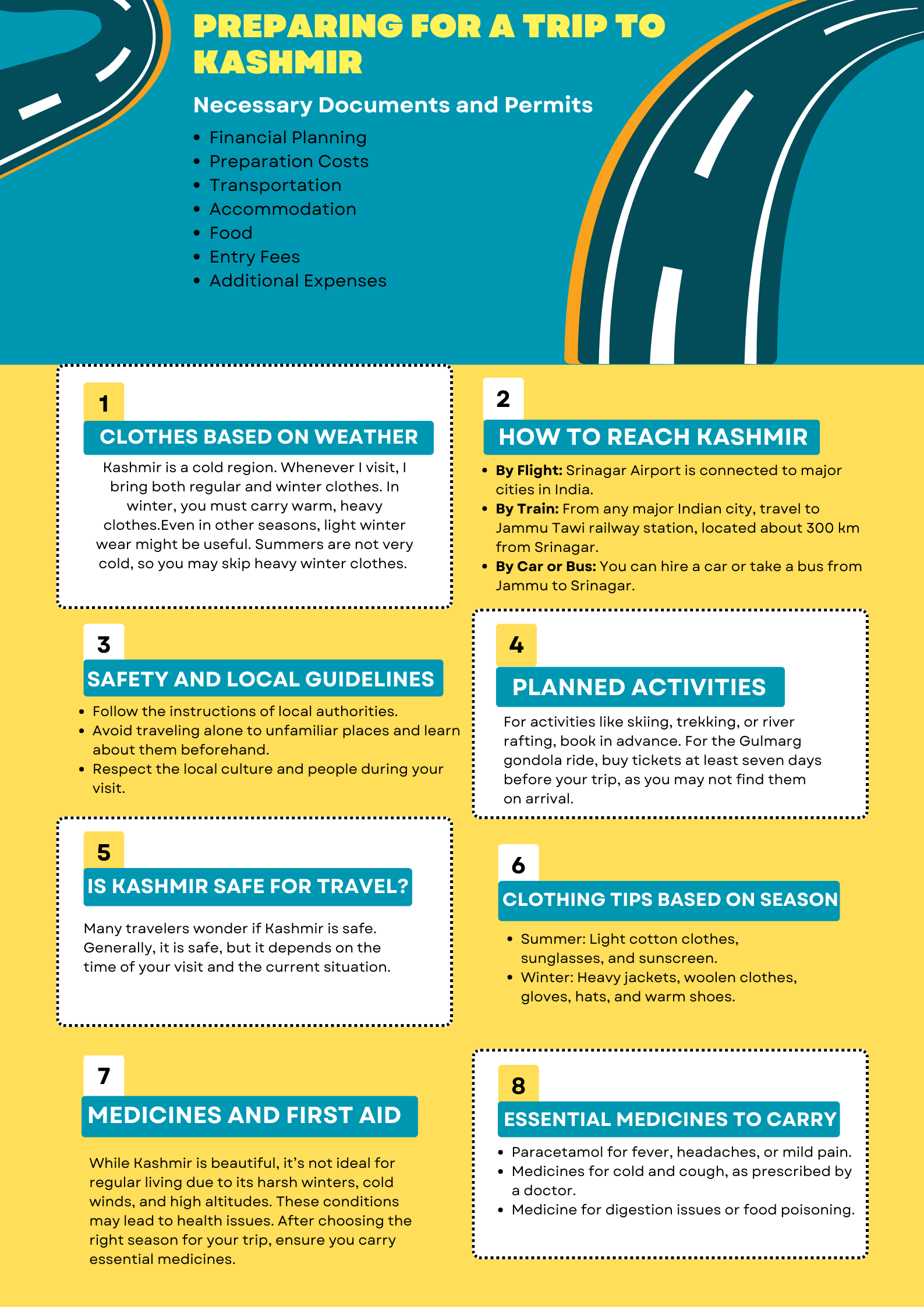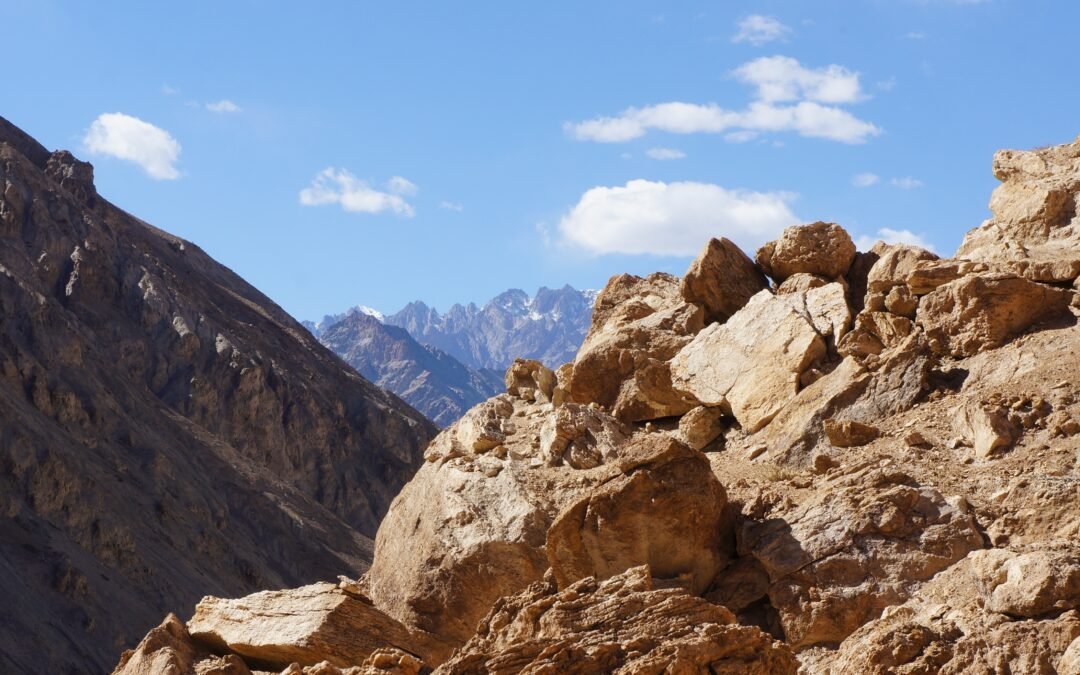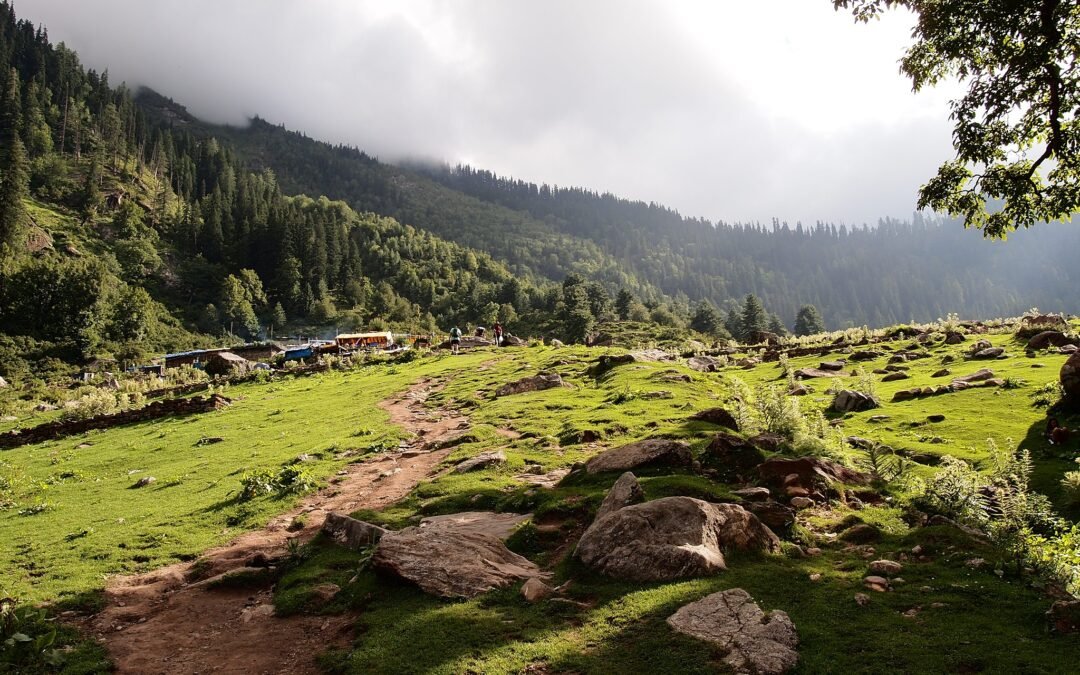
A Comprehensive Guide for a Safe Journey
For nature lovers, Kashmir is a dream destination. With its snow-covered mountains, flowing rivers, green valleys, and stunning landscapes, Kashmir attracts countless tourists every year. However, proper preparation is crucial before embarking on a trip to Kashmir. I started planning my trip nearly a year in advance.
You might wonder, “Why so much preparation?” If it were any other place, your question might be valid. But Kashmir’s weather varies across seasons, and it has numerous tourist spots to explore. Typically, a trip to Kashmir lasts 3-7 days, so without adequate preparation, you may face difficulties. This article aims to help you plan a smooth and enjoyable journey to Kashmir. By following these tips, your trip will be safe, memorable, and hassle-free. Start preparing now for an amazing experience!
Traveling to Kashmir requires some preparations that should be made in advance. I personally planned at least a year ahead. To help you create a beautiful plan and preparation, I’ve decided to write this blog.
Many of you might be wondering what the preparations are. If it were any other place, I would agree with you; however, since this is Kashmir, the weather varies in each season. Furthermore, traveling to Kashmir is never limited to just a day or two; it typically involves at least three, four, or even five to seven days. So, I must support my own argument. You should read my blog carefully. You could travel without reading it, but you might find yourself struggling at every moment. I’ll inform you about what you can see, what essential medicines to bring, what clothing is necessary, and how much money you should carry. So, let’s gather some information for a well-organized trip.
Choosing the Best Time to Visit Kashmir

Your trip’s success depends on when you visit and what kind of natural beauty you wish to experience. Kashmir offers unique charms in every season, so you must decide based on your preferences.
Seasons
If you want to travel but can’t decide what kind of natural beauty you want to see, your trip could be spoiled. Alternatively, your amazement could be limitless! Now, do you want to come here with such uncertainty? Or would you prefer to come to know the extraordinary beauty of nature?
I have visited here several times. Each season presents a different beauty. The first time I came during winter, in January, it had turned into a snowy wonderland. The mountains were covered in snow, and it was snowing in the afternoons. This period is mainly from December to February. If you want to ski in the snow or have a desire to ride on a sleigh, winter is the best time for your trip. However, you should keep in mind that if you have children or elderly people with you, you need to consider how well they can tolerate extreme cold. If you’re afraid of the cold, winter may not be the right time.
If you want to be surrounded by greenery, June to July is an ideal time. Nature is exquisitely beautiful then. The mountains are adorned with towering pine trees, and the valleys are filled with blooming flowers.
The second-largest tulip garden in the world is located in Srinagar, Kashmir. It is open from mid-March to mid-April when the tulip flowers bloom. It is closed for the rest of the year. So, if you want to be mesmerized by the beauty of tulip flowers, you must plan for this time! Just imagine how disappointing it would be to come here in May, filled with a desire to see the tulip garden! Therefore, before coming to Kashmir, make sure to find out when you can witness the beauty of Kashmir. Then come and enjoy to your heart’s content.
Summer (March-June):
The weather is pleasant during this time. You can enjoy the lush green valleys of Dal Lake, Gulmarg, and Pahalgam.
Kashmir is home to the world’s second-largest tulip garden, located in Srinagar. The garden is open from mid-March to mid-April, when tulips are in full bloom. If you visit in May, you’ll miss this sight, which can be disappointing. Plan your trip accordingly to witness this breathtaking view.
Monsoon (July-September):
If you love greenery, July is an ideal time to visit. The mountains are covered with pine trees, and the valleys are adorned with flowers.
While some areas may be challenging to explore during the monsoon, there are fewer crowds, and travel expenses are lower.
Autumn (October-November):
In autumn, the landscapes are decorated with colorful leaves, and apple orchards are full of fruit. If you wish to taste fresh apples and enjoy apple juice, October is the best time to visit. By the end of autumn, temperatures begin to drop, and snow starts accumulating on the mountains.
Winter (December-February):
When I visited in January, Kashmir was transformed into a snowy wonderland. Snowfall is common, especially in Gulmarg, which is ideal for skiing and sledding. However, if you’re traveling with young children or elderly companions, be cautious, as they may struggle with the extreme cold.
Clear Understanding of Kashmir's Tourist Spots
The paradise of Kashmir is filled with countless known and hidden tourist spots that will mesmerize nature lovers. You should familiarize yourself with these places before visiting. Based on my travel experience, here’s a brief overview of some key spots:
Srinagar:
The capital city of Kashmir, Srinagar, is a treasure trove of natural beauty. Its charm changes with the seasons—snow-covered in winter and vibrant with tulips in spring. Famous attractions include Dal Lake’s houseboats, shikara rides, and the floating market. Historic Mughal gardens like Shalimar Bagh, Nishat Bagh, Pari Mahal, and the Tulip Garden further enhance Srinagar’s allure, with the Tulip Garden being a major draw in March and April.
Srinagar also has traditional religious sites like the Shankaracharya Temple and Hazratbal Mosque. The temple offers a stunning panoramic view of the city, while the Hari Parbat Fort combines history and nature beautifully.
Gulmarg:
Known as the meadow of flowers, Gulmarg offers snow-covered mountains, skiing, and gondola rides. The gondola takes visitors up to 14,000 feet, providing breathtaking snowy views. Even in summer, snow can still be seen here. The Drung Waterfall adds to the excitement, turning into a frozen spectacle in winter.
Pahalgam:
Located 100 km from Srinagar, Pahalgam is famous for its natural beauty. Notable spots include Aru Valley, Betaab Valley, and Baisaran Valley, with Baisaran often called “Mini Switzerland” due to its lush green surroundings and mountain views. Activities like horseback riding and zip lining are popular here. Additionally, the Amarnath Yatra pilgrimage starts from Chandanwari near Pahalgam.
Sonmarg:
About 80 km from Srinagar, Sonmarg is home to the Thajiwas Glacier and Zero Point, where temperatures remain below freezing year-round. Its parks are perfect for relaxation and enjoying the serene environment.
Necessary Documents and Permits

Certain documents and permits are essential for traveling to Kashmir. As a foreign tourist, you must carry these with you. Before visiting, ensure you have all the required papers and permissions. Follow your country’s rules for traveling to India. Check your national ID (NID) and ensure your passport is valid.
Many tourists opt for travel insurance to handle accidents or emergencies. Although not mandatory, you can choose to get insurance for added safety. It’s up to your personal preference and security needs.
Financial Planning
Money is one of the most critical aspects of travel. Even though you’ve planned your trip, here’s some guidance based on my experience:
Preparation Costs:
Before heading to Kashmir, you’ll spend money gathering documents and buying necessary items for your trip.
Transportation:
Your travel expenses depend on whether you’re taking a flight, train, or bus to Kashmir. Within Kashmir, local transport will also cost you. For adventurous activities like horseback riding, each ride may cost 2,000–4,000 INR.
Accommodation:
Expenses will include staying in hotels, resorts, or houseboats.
Food:
While local food is affordable, trying various delicacies might increase your food budget. Kashmir has many traditional dishes you won’t want to miss, so plan accordingly.
Entry Fees:
You’ll need to pay entry fees for places like the Mughal gardens. For example, a gondola ride in Gulmarg costs 750–1,700 INR, while a shikara ride in Dal Lake costs 750–1,200 INR.
Additional Expenses:
Set aside extra money for shopping or souvenirs. Kashmiri handicrafts, clothing, and spices are worth buying but can be expensive.
For a 3-7 day trip (excluding transportation to Kashmir), expect to spend 30,000–80,000 INR. Calculate your total expenses based on where you’re traveling from, your mode of transport, and whether you’re traveling solo, with a companion, or on a group tour. Solo trips tend to cost more, while group tours can significantly reduce expenses.
Your Kashmir trip cost will depend on your travel style and duration.
Clothes Based on Weather
Kashmir is quite a cold region. Whenever I’ve been here, I’ve always brought winter clothing along with regular clothes. If you’re visiting during winter, it’s essential to have heavy winter wear. In other seasons, you might still need some winter clothing depending on the situation. Since it doesn’t get very cold in summer, you can choose not to bring heavy winter clothes. In that case, you can rent jackets at tourist spots during winter. Ultimately, it depends on your personal preferences.
From my travel experience, I can say that bringing regular winter clothes is preferable. This way, you can manage your luggage size. Since a trip here usually lasts several days, it’s better to rent heavy winter clothes rather than bring them all. In this area, you can rent each outfit for around 150 to 200 rupees. Sometimes they may ask for more, so negotiate. However, if you have the budget, you can also buy a winter jacket. You can negotiate to buy one in the local markets of Srinagar for about 1200 to 1500 rupees. Keep in mind that buying from floating shops on Dal Lake or street-side shops might be more expensive.
Make sure to bring gloves during winter. I couldn’t find anything to rent or buy nearby. If you go to Doodhpathri or the zero point in Sonmarg, not having gloves can be uncomfortable.
You’ll need snow boots to walk in the snow, but there’s no need to buy them. You can rent them there for about 150 to 200 rupees.
In winter, you must carry warm, heavy clothes. Even in other seasons, light winter wear might be useful. Summers are not very cold, so you may skip heavy winter clothes. If needed, you can rent jackets at tourist spots for a small fee.
From my experience, bringing basic winter wear is better to reduce luggage size. Since you’ll be on a long tour, renting heavy winter clothes is practical. Jacket rentals typically cost ₹150-₹200 but could be higher depending on demand. If it fits your budget, you can also buy winter jackets from local markets in Srinagar for ₹1,200-₹1,500. Avoid buying from floating markets on Dal Lake or roadside shops, as prices may be higher.
One essential item is gloves. I couldn’t find gloves for rent or purchase when I needed them at places like Doodhpathri or Zero Point in Sonmarg. Without gloves, it can feel uncomfortable.
Snow boots are necessary for walking in snow, but there’s no need to buy them. You can rent a pair for ₹150-₹200.
Clothing Tips Based on Season:
- Summer: Light cotton clothes, sunglasses, and sunscreen.
- Winter: Heavy jackets, woolen clothes, gloves, hats, and warm shoes.
- Rainy Season: Raincoats and waterproof shoes.
- For Trekking in Hilly Areas: Light clothes, trekking shoes, and a sleeping bag.
Medicines and First Aid
We often refer to Kashmir as a land of beauty, but it’s not the most suitable place for regular living. Intense cold, freezing winds, and high mountains can expose you to adverse conditions. Therefore, after deciding on the season for your trip to Kashmir, you need to carry some essential medicines. I consulted a specialist doctor and brought some medications for potential cold-related issues. Additionally, if you’re going to high altitudes, you might face breathing difficulties, so I also packed medicines as per the doctor’s advice. Along with the regular medications I take, I also brought enough medicines for fever, headaches, pain relief, and stomach issues. It’s essential to keep these medicines handy for a hassle-free trip. You might find them there, but having them with you is convenient.
While Kashmir is beautiful, it’s not ideal for regular living due to its harsh winters, cold winds, and high altitudes. These conditions may lead to health issues. After choosing the right season for your trip, ensure you carry essential medicines. I consulted a doctor and brought medicines for cold-related problems. You may also experience breathing difficulties at high altitudes, so carry prescribed medication for that.
Apart from regular medicines, I brought enough for fever, headaches, pain relief, and stomach issues. Having these on hand can ensure a smooth trip, though they’re usually available locally.
Additionally, chewing gum helped prevent throat dryness while walking in hilly areas. A small hotpot for warm water can be useful, especially in freezing conditions, though warm drinks are widely available there.
I almost forgot to mention one more thing. I also brought some chewing gum to help soothe my throat while walking on the mountain slopes. At the mountain top, if you want to relieve the cold, you can get hot water at small hot spots, though you’ll find various hot food and drink options there as well.
Also Read:Itinerary For Goa
Essential Medicines to Carry:
- Paracetamol for fever, headaches, or mild pain.
- Medicines for cold and cough, as prescribed by a doctor.
- Medicine for digestion issues or food poisoning.
- Medicine for altitude sickness if traveling to high-altitude areas.
- A basic first aid kit (bandages, antiseptic cream, and gauze).
Packing Personal Items
You’ll need several personal items for your trip to Kashmir. Carrying these will make your journey more comfortable. For a great travel experience, consider packing:
- A high-quality backpack to store your belongings.
- A water bottle of any size based on your needs.
- A camera and charger if you enjoy photography.
- A power bank, along with your mobile phone and its charger.
- A map of Kashmir or a navigation app installed on your phone.
Choosing Your Travel Route (How to Reach Kashmir)
Here are some common routes to reach Kashmir:
- By Flight: Srinagar Airport is connected to major cities in India. You can fly to cities like Kolkata, Mumbai, or Delhi from any country and then reach Srinagar Airport. From there, take local transport to your destination.
- By Train: From any major Indian city, travel to Jammu Tawi railway station, located about 300 km from Srinagar. From there, take a taxi or local bus to Kashmir.
- By Car or Bus: You can hire a car or take a bus from Jammu to Srinagar. However, the long journey may not be very comfortable by bus.
Choose the route that best suits your convenience.
Safety and Local Guidelines
While traveling in Kashmir, keep these safety tips in mind:
- Follow the instructions of local authorities.
- Avoid traveling alone to unfamiliar places and learn about them beforehand.
- Respect the local culture and people during your visit.
- Use a local SIM card for communication and learn how to get one.
- Be cautious about accepting food or drinks from strangers.
Planned Activities
- Adventure: For activities like skiing, trekking, or river rafting, book in advance. For the Gulmarg gondola ride, buy tickets at least seven days before your trip, as you may not find them on arrival.
- Shopping: Carry an extra bag for items like Pashmina shawls, saffron, and carpets.
- Photography: Bring a camera or extra storage devices to capture the beautiful scenery.
Money
Money is the most important aspect. However, I saved this for last so you don’t get overwhelmed! Even if you have money, you need to plan your traveling to Kashmir wisely. From my travel experience, I can provide you with some helpful information.
For a complete trip of 5 to 7 days, your transport costs to Kashmir could range from 30,000 to 80,000 rupees. Depending on your shopping habits, you can estimate your expenses. You should also consider how you’re traveling to Kashmir—by plane or train—to calculate the total trip cost. Expenses will also vary based on whether you’re traveling alone, with a companion, or as part of a group tour. Traveling alone can be more expensive; with a companion, costs per person decrease; and group tours significantly lower expenses.
I hope you take the time to prepare, and like me, you’ll have a wonderful travel experience!
Is Kashmir Safe for Travel?
Many travelers wonder if Kashmir is safe. Generally, it is safe, but it depends on the time of your visit and the current situation. While Kashmir is a stunning destination, it occasionally faces political or security issues. Here’s what to consider:
- Current Situation: Before traveling, check recent security updates through local or international news.
- Follow Guidelines: Adhere to instructions from the Indian tourism department or local authorities.
- Tourist Areas: Popular spots like Srinagar, Gulmarg, Pahalgam, and Sonmarg are generally secure and rarely experience instability.
- Local Guides: Hiring an experienced and registered local guide can make your trip safer, though it may not be necessary if you’re well-informed.
With proper preparation and up-to-date information, traveling to Kashmir can be safe. You can also visit our website or follow us for reliable information.
Conclusion
A trip to Kashmir can be a memorable experience with the right planning and preparation. By organizing your time, budget, and essential items in advance, your journey will be smooth and enjoyable. Relish every moment and cherish Kashmir’s unique natural beauty as part of your life’s memories.
Take your time to prepare, and like me, you’ll have an incredible travel experience. Thank you!






0 Comments